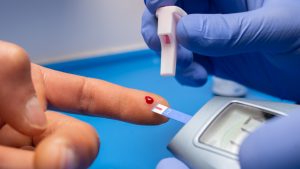Diabetes, if not managed properly, can lead to serious complications affecting various systems in the body. One of the most common and debilitating is diabetic neuropathy. This condition occurs when high blood glucose levels damage nerves, leading to a wide range of symptoms and significantly impairing quality of life. In this article, we will delve deep into what diabetic neuropathy is, its causes, symptoms, diagnosis, treatment, and how we can effectively prevent and manage it.
What is diabetic neuropathy? Diabetic neuropathy is a chronic complication of diabetes characterized by nerve damage caused by high blood glucose levels. This damage can affect both peripheral nerves (which innervate the arms, legs, and internal organs) and autonomic nerves (which control involuntary body functions, such as heart rate and digestion). Diabetic neuropathy can develop gradually and worsen over time if left untreated.
Types of diabetic neuropathy:
- Peripheral neuropathy: Primarily affects the nerves of the extremities, causing symptoms such as numbness, tingling, sharp or burning pain, loss of sensation, muscle weakness, balance problems, and coordination issues.
- Autonomic neuropathy: Affects the nerves that control involuntary body functions, such as digestion, heart rate, and blood pressure. Symptoms may include gastrointestinal problems, erectile dysfunction, urinary incontinence, excessive or insufficient sweating, dizziness upon standing, and changes in heart rate.
- Focal neuropathy: Affects a specific area of the body, such as a single nerve.
- Proximal neuropathy: Affects the nerves closer to the center of the body, causing pain and weakness in the legs.
Causes and risk factors The primary cause of diabetic neuropathy is hyperglycemia, or high blood glucose levels over a prolonged period. When glucose levels are too high, they can damage the small blood vessels that supply nutrients to nerves, leading to neuropathy. Other risk factors include:
- Imbalance of other nutrients: Elevated levels of lipids and proteins in the blood.
- Oxidative stress: Cell damage caused by free radicals.
- Inflammation: Abnormal immune response.
- Genetic factors: Predisposition to developing neuropathy.
Common symptoms The symptoms of diabetic neuropathy can vary widely depending on the nerves affected. Some of the most common symptoms include:
- Peripheral neuropathy: Numbness, tingling, burning, sharp or dull pain, loss of sensitivity to heat, cold, or pain, muscle weakness, loss of reflexes, difficulty walking.
- Autonomic neuropathy: Gastrointestinal problems (nausea, vomiting, constipation, diarrhea, dysphagia), cardiovascular problems (tachycardia, orthostatic hypotension, heart failure), urogenital problems (urinary incontinence, erectile dysfunction, recurrent urinary tract infections).
- Focal neuropathy: Depends on the nerve affected but may include facial paralysis, eye pain, or difficulty swallowing.
Diagnosis The diagnosis of diabetic neuropathy is based on a combination of factors, including:
- Neurological physical examination: Evaluation of reflexes, muscle strength, sensation, and coordination.
- Nerve conduction studies: Measure the speed at which nerve impulses travel along a nerve.
- Electromyography: Evaluates the electrical activity of muscles in response to nerve stimulation.
- Nerve biopsy: A small sample of nerve tissue is removed for examination under a microscope.
Treatment The goal of treatment is to control symptoms, prevent complications, and improve quality of life. Treatment options may include:
- Strict control of blood glucose: It is essential to maintain glucose levels within the target range.
- Pain medications: Analgesics, antidepressants, and anticonvulsants can help relieve neuropathic pain.
- Physical therapy: Specific exercises can help improve muscle strength and coordination.
- Medical devices: Special footwear, insoles, and braces can help protect the feet and improve comfort.
- Treatment of complications: Infections, ulcers, and other complications of diabetic neuropathy should be treated promptly.
Prevention The best way to prevent diabetic neuropathy is to maintain good control of diabetes. Other preventive measures include:
- Strict control of blood glucose: Regularly monitor glucose levels and adjust treatment as needed.
- Foot care: Inspect feet daily, wear appropriate footwear, and avoid walking barefoot.
- Healthy diet: Consume foods low in saturated fats and cholesterol and high in fiber.
- Regular physical activity: Regular exercise can improve circulation and reduce the risk of neuropathy.
- Quit smoking: Smoking worsens circulation and increases the risk of diabetes complications.
Living with diabetic neuropathy Living with diabetic neuropathy can be challenging, but there are many strategies to improve quality of life. These include:
- Pain management: Use relaxation techniques, physical therapy, and medications to control pain.
- Home modifications: Make changes to the home to improve safety and comfort, such as installing grab bars in the bathroom.
- Emotional support: Join support groups and talk to a therapist to cope with emotional challenges.
Conclusion Diabetic neuropathy is a serious but manageable complication of diabetes. By understanding the causes, symptoms, and treatment options, people with diabetes can take steps to prevent or delay the progression of the disease and improve their quality of life.
E4 Helps you:
At E4, we’re dedicated to revolutionizing how people manage type 2 diabetes through our innovative E4 Alive program. Our team of specialists has joined forces to create a comprehensive solution aimed at empowering individuals to take charge of their health journey. With personalized support and resources tailored to each person’s unique needs, we make managing diabetes simpler and more effective than ever before.
E4 Alive offers a range of tools and resources to help you better understand and control your blood sugar levels. Our program provides personalized guidance to create a healthy eating plan and integrate regular physical activity into your daily routine. Plus, you’ll have access to a supportive community of individuals who understand your challenges and are there to offer encouragement and guidance every step of the way.
By joining E4 Alive, you can effectively manage your blood glucose levels, improve long-term glycemic control, reduce your risk of diabetes-related complications, and enhance your overall quality of life. It’s not just a program; it’s an opportunity to reclaim your health and vitality. Ready to start your journey to better health? Visit THIS PAGE to learn more about E4 Diabetes Solutions and the E4 Alive program.
To learn more about E4 Diabetes Solutions and the E4 Alive program, visit THIS PAGE.

Type 2 Diabetes: Is It Really Reversible?
A recent National Geographic article [link] explores how type 2 diabetes could be reversible with the right approaches. This condition, which affects millions of people worldwide, has long been considered a chronic and progressive disease. However, recent research challenges this perception and suggests that with lifestyle changes and the right approach, remission is possible. The

How Do GLP-1 Drugs Compare? A Breakdown of Ozempic, Mounjaro, and Trulicity
GLP-1 receptor agonists have revolutionized diabetes management, with drugs like Ozempic, Mounjaro, and Trulicity leading the market. But how do these medications compare in terms of effectiveness, side effects, and patient outcomes? Let’s explore their differences and what they mean for diabetes patients. Understanding GLP-1 Medications GLP-1 receptor agonists mimic a natural hormone that helps

Why Has Medicare Spending on Diabetes Medications Skyrocketed in 5 Years?
In the past five years, Medicare spending on diabetes medications has increased nearly fivefold, reaching $35.8 billion in 2023. This surge has been primarily driven by the growing use of GLP-1 drugs such as Ozempic, Mounjaro, and Trulicity. But what is behind this cost escalation, and how does it affect patients and the U.S. healthcare

The Gut Microbiota and Blood Sugar Control: A Hidden Connection
The human gut is home to trillions of bacteria that play a crucial role in digestion, immune function, and even metabolism. Recent research has revealed a fascinating link between the gut microbiota and blood sugar regulation, shedding light on how the balance of microbes in our intestines can influence diabetes risk and overall metabolic health.

The Dawn Phenomenon: Why Blood Sugar Rises While You Sleep
For many people with diabetes, waking up with high blood sugar levels can be frustrating—especially if they didn’t eat anything overnight. This early-morning spike in blood glucose is known as the Dawn Phenomenon, and it happens due to natural hormonal changes in the body. But why does it occur, and how can it be managed?

The Influence of Red Light on Blood: Can It Improve Diabetes?
Type 2 diabetes is a metabolic disease characterized by insulin resistance and elevated blood glucose levels. In the search for complementary alternatives to improve glycemic control, red light therapy has gained attention due to its potential to enhance circulation, reduce inflammation, and optimize cellular function. But what does science say about it? ✨ What is

